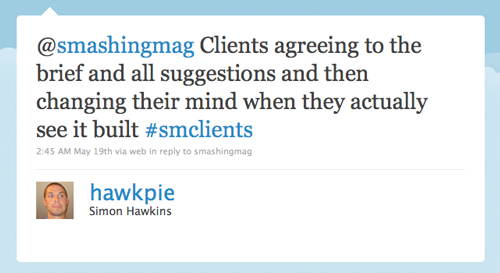Turning All Clients Into Dream Clients (or Common Client Difficulties)

 |
Clients can be tough… real tough. Working side by side with some clients can be an agonizing experience — an experience so painful that you often wonder what exactly you have gotten yourself into. On the other hand, some clients are an absolute dream to work with. Every day spent working with them reminds you why you became a Web designer and just how enjoyable your job actually is. The question then is, how do we take our most difficult clients and turn them into dream clients? The answer may be easier than you realize.
Clients often require a bit of hand-holding. When dealt with correctly, this is not too overwhelming; it just calls for some simple guidance. You may be surprised by how a few extra emails here and there can make a world of difference. Outlined here are some of the most common client difficulties our Twitter followers have run into and how to best resolve them.
Also consider our previous articles:
- How to Successfully Educate Your Clients on Web Development
- There’s No Such Thing as a Bad Client
- How to Explain to Clients That They are Wrong
- Dealing With Clients Who Refuse to Pay
- 8 Strategies for Successful Relations With Clients
[By the way, did you know we have a free Email Newsletter? Subscribe now and get fresh short tips and tricks in your inbox!]
Common Client Difficulties
Doesn’t Know What They Want

“They have no idea what they want!” (@daveom)
More often than none, clients have no idea what they want and look to you for your expertise. For a designer, it can be annoying. Then again, how many times have you been to a restaurant and had no idea what to order and asked for a recommendation? Clients are no different. They are looking for recommendations, not fixed solutions. Talk it over with them, get all the details, and then start making educated recommendations. As ideas start to bounce around, one will hit home and provide a base from which to work.
It takes a great deal of patience, but getting all of the necessary information and building a solid starting point will not only help you throughout the project, but also reassure the client that they made the right decision.
Feels Left Out of Process

“They never feel ‘in the loop’ — so to solve this, I try to call them each week for an update and a chat.” (@jaaved)
Communication is the foundation of any successful client relationship. When this foundation starts to slip, the relationship begins to crumble. Starting a project on the same page as the client is easy, but staying on the same page throughout the project requires tenacity.
At the beginning of each project, create a calendar outlining a timeline of events for the project. The calendar should explain when the client can expect certain tasks to be completed and when they will need to provide certain information. A calendar is just the start to keeping the client in the loop; it should be followed up with regular emails and phone calls. If you are making a change that will take up to a day or two, send a quick email to let the client know. A quick email takes only a minute to send, and it assures the client that you are indeed working. Simple and small efforts such as these keep the client happy and informed of the entire process.
Changes Mind Midway

“Clients agreeing to the brief and all suggestions, and then changing their mind when they actually see it built.” (@hawkpie)
It’s bound to happen sooner or later: you start a project, things are going well, and then the client gets a new idea. They request that you scrap what you’ve done so far and move in another direction. All of your hard work and effort, which the client originally wanted, is wasted — or so you suspect.
In reality, merging what the client originally wanted with the new direction may be completely possible. Keep an open line of communication and work out the reasoning behind the new direction. What they want might not be far off from what you’re actually doing, and mixing in a few new details may not be too difficult.
The initial shock of a request for a new direction is often worse than it seems. Keep a good attitude, and work it out with the client professionally. If the client refuses to meet you in the middle, you should have a solid contract to back up the project, and bill them for the extra work accordingly.
Doesn’t Understand Web Design

“General lack of knowledge.” (@robbclarke)
When I take my car into the shop for a repair, the mechanic knows to speak to me in terms I will understand. If they go into detail about how my carburetor is not getting the right fuel-to-oxygen intake ratio of 14.7:1, then I look at them as though they are speaking a foreign language. The same is true with our clients. If I explain to them that the layout is based on a 12-column 960-pixel-wide grid, in which everything in the left column needs to stay within 220 pixels, then they would look at me as though I was speaking a foreign language as well.
Our job as Web designers is to educate our clients. That is neither easy nor glamorous, but working with an educated client is much more pleasurable. When a client fully understands what you are doing and why you are doing it, then they are much more welcoming of your changes, and they’ll often even offer quality suggestions. Remember, what is obvious to you may not be obvious to them, so be as accommodating as possible.
Doesn’t Provide Enough Information

“Asking specific questions and getting vague replies, then clients thinking you’re slow in some way when you ask again.” (@Shellra)
Client requests are not uncommon. If a client is not a fan of a blue button, they will tell you so. Being such a polite designer, you change the color of the button. But upon changing it, the client mentions that what they really meant is that they want the button to stand out more. Again, being the polite designer, you make it stand out more. Following this change, the client says that you are getting closer to what they want but that they would like to see the button in blue. Not so politely anymore, you want to know what the problem is. Your button was blue to begin with — what really is the problem?
This type of situation happens all too frequently and is extremely frustrating. The client thinks you are senseless for not understanding what they want, and you think the client is ignorant for not giving you all the necessary details. The quarrel could go on for ages, and no one would win.
When a client provides insufficient detail, go back to them and explain in great detail that you are not too sure what they are looking for. Explain that the more information they give and the better they describe what they’re looking for, then the better you can deliver what they want. Ask for an example or approximation of what they’re looking for. Make sure they understand that the more guidance you get, the better. If you feel you are not getting the details you need, don’t be afraid to jump on the phone with them to hash out the details. Playing the guessing game is the quickest way to burn out. Avoid it at all costs.
Expectations Are Too High

“How about expecting the earth on a shoestring budget and wanting it by 5:30 pm.” (@fruitymilk)
One of the most difficult parts of being a Web designer is managing client expectations. Clients will often come with a list of requests that they presume is not all that difficult to achieve… and that they expect will turn their website into the next best social network. On top of a laundry list of demands, the client also informs you that they are working on a very limited budget and short timeframe. To them, you “do this kind of thing all the time,” and so doing it for them should be a walk in the park. Sadly, they are wrong, and no one but us is at fault.
Christina Krasovich puts it best: “If you don’t manage client expectations, you will never exceed client expectations.” If we do not regularly communicate with our clients about what we are doing and what is feasible, then no wonder they think we have the power to move oceans. Continually keep them informed of the project’s progress, and discuss complications as they arise. A client who is kept in the dark will not know how difficult anything is to accomplish. They will be dumbfounded when you balk at a request.
When negotiating a new project, explain to the client the difficulty of what they are requesting. Let them know that the task they would like to be performed requires time and money to complete. Correctly managing expectations keeps the client at bay. Exceeding expectations will have them praising you.
Struggles to Pay on Time

“Paying on time is my biggest difficulty with clients, especially with larger companies.” (@thefunkhouse)
Staying afloat is extremely difficult when a client struggles to pay on time. Even one late payment is enough to cause a great deal of suffering. But as in any industry, when you take on a job, you run the risk of not being paid in full. You never expect not to be paid, of course, but you can take certain steps to soften the blow when a client struggles to pay.
To begin, keep your expenses as low as possible. Do you really need an account for stock photography, or are enough free resources online for you to work for the time being? Just because your income is at a certain level does not mean you need to spend it all. Save your money for operational costs the next time a client pays late.
Also, write a solid contract, and request a decent deposit before starting. If a client is sluggish about making a deposit, this may be a strong indication of things to come: proceed with caution. In the contract, clearly state when payment is due and what are the penalties should the client pay late. Review this part of the contract with the client before signing it, making sure they are fully aware of the penalty.
Be open and honest with the client about payment. Stay on top of them, pleasantly reminding them when their invoice is coming up and when payment is due.
One Day At A Time
At the end of the day, the very least you can do is treat your client with respect and hope they treat you in turn. All of the communication and assistance in the world will not mean a thing if it is done with contempt.
Some clients will be rougher than others, and that’s fine. Keep your head up, and don’t give in. Continue to work with them, educating them, making compromises and working together. When you and a client are happy with each other, the opportunities are endless. Before shrugging off the next client who throws a fit, take a different approach. With a little extra effort, you never know — they may just end up being the client of your dreams.
Additional Resources (And Laughs)
- 5 Simple Tips for Improving Designer-Client Relationships, from Noupe
- 10 Sure-Fire Ways to Make Your Clients Love You, from Design Shack
- On Being a Bad Client, from MIX Online
- What Clients Say vs. What They Mean, from Freelance Switch
- 13 Tips for Effective Communication With Clients, from DesignM.ag
- Uh-Oh! Seven Steps to Deal With an Unhappy Client, from Freelance Folder
- Working With a Bad Client, from letscounthedays
- The Website Owner’s Manual, by Paul Boag
- Clients from Hell
(al)
© Shay Howe for Smashing Magazine, 2010. | Permalink | Post a comment | Add to del.icio.us | Digg this | Stumble on StumbleUpon! | Tweet it! | Submit to Reddit | Forum Smashing Magazine
Post tags:

- Login om te reageren






